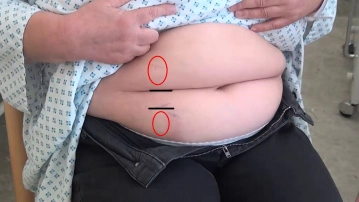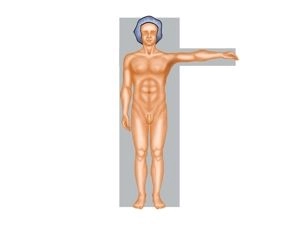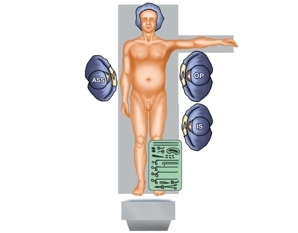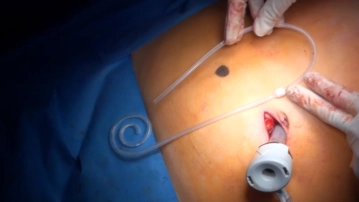- End-stage renal disease with planned peritoneal dialysis
-
Indications
-
Contraindications
- Patient not suited for peritoneal dialysis
- Abdominal cavity filled with polycystic kidneys
-
Preoperative diagnostic work-up
- Clinical examination: Abdominal wall hernia? History of abdominal surgery?
- Abdominal ultrasound study: Ruling out malignancies, assessing the size of polycystic kidneys and renal cysts
-
Special preparation
![Special preparation]()
Sitting position: Mark possible catheter exit sites outside of waistband and skin folds in red
1 week before surgery
- No more heparin or insulin injections into the abdominal wall, thereby sparing the surgical site and reducing the risk of infection
Day before surgery
- Standard preparation for surgery including umbilical care
- Enema the evening before the procedure
- Last meal the evening before surgery
- Preoperative markup with the patient standing and sitting
Since the CAPD is performed by the patient the catheter exit site must be easily visible for him/her. Thus, the exit site must not be located at the level of the waistband (outerwear/underwear), in skin folds or below a pendulous abdomen. Since most patients change the dialysate while sitting, the planned catheter exit site should also be checked before surgery with the patient sitting. The side of the catheter exit site – right or left – should not be specified beforehand because it may depend on possible adhesions discovered during the procedure.
Day of surgery
- Single-shot antibiotic before anesthesia is initiated
- Possibly Foley catheter for the duration of surgery
-
Informed consent
- Primarily for laparoscopy with assessment of the abdominal cavity
- Possibly for laparoscopic adhesiolysis
Complications
- Injury to the small and large intestines
- Injury to parenchymal organs
- Wound infection, abscess, peritonitis, revision surgery
- Abdominal wall hematoma, cutaneous emphysema
- Postoperative shoulder pain
- Thromboembolism
Catheter specific complications
- Catheter kinking
- Catheter malposition, leakage
Postoperative care
- Strict bed rest for 2 days
- Getting up only permitted when going to the bathroom
-
Anesthesia
-
Positioning
![Positioning]()
Supine, one arm abducted
-
Operating room setup
![Operating room setup]()
As demonstrated in this video, here the catheter is inserted in the lower right quadrant:
- Surgeon: To the left of the abdomen
- Assistant: To the right of the abdomen
- Scrub nurse: On same side as surgeon, at patient thigh level
-
Special instruments and fixation systems
![Special instruments and fixation systems]()
- Standard surgical tray including stylet for drains (16 French)
- Laparoscopy unit
- Possibly laparoscopic instruments for adhesiolysis
- CAPD catheter set
-
Postoperative management
Postoperative analgesia
- Follow this link to PROSPECT (Procedure Specific Postoperative Pain Management)
- Follow this link to the International Guideline Library.
Wound care, dressing changes
- Daily wound care
- Dressing at catheter exit site changed on postoperative day 2 or 3
- Dialysis catheter flushed daily by trained staff experienced in dialysis
Medical deep venous thrombosis prophylaxis
- Starting the evening before surgery and continued for the duration of the hospital stay
- Follow this link to the to the International Guideline Library.
Postoperative ambulation
- Strict bed rest for 2 days, breathing and metabolic physiotherapy
- On days 3 and 4 the patient may only get up for the bathroom
Diet
- The evening before surgery: Tea
- Postoperative day 1: Liquid diet
- Starting postoperative day 2: Regular diet
- Possibly laxatives on postoperative day 3
Work disability
2–4 weeks, depending on the patient’s profession




